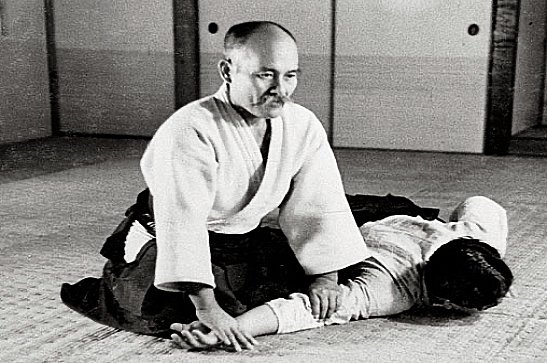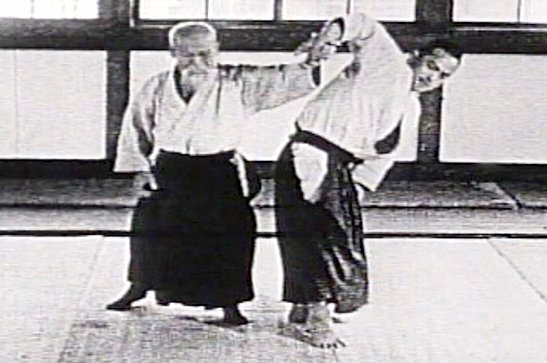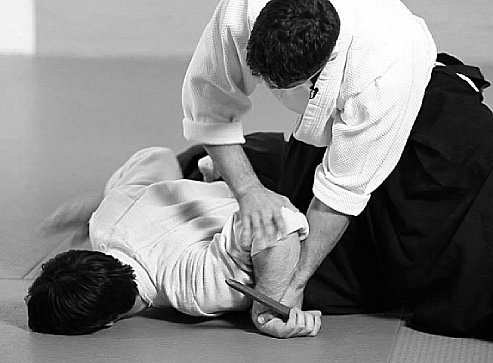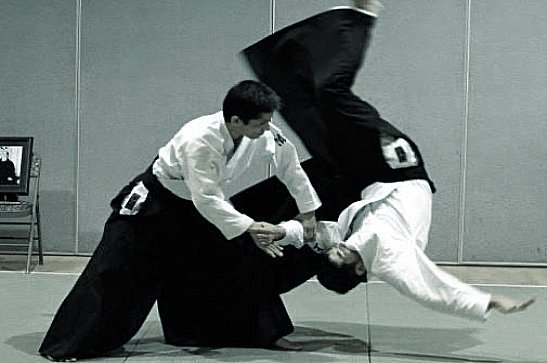Techniques of Aikido

Aikido Training
Aikido techniques emphasize blending with an opponent's energy
rather than meeting force with force. Practitioners use circular
movements, joint locks, and dynamic throws to redirect an attack and
neutralize aggression. Techniques such as irimi (entering movements)
and tenkan (turning movements) allow the defender to reposition
themselves strategically, using an attacker's momentum against
them. Joint locks like ikkyo, nikkyo, sankyo, and yonkyo control
an opponent through pain compliance and immobilization, while
throws such as shihonage (four-direction throw) and kote gaeshi
(wrist turn throw) unbalance and subdue them with minimal effort.
Aikido’s techniques are rooted in the principle of non-resistance,
aiming to resolve conflicts without unnecessary harm, making it
an effective martial art for self-defense and personal development.
Ikkyo (First Teaching)
Ikkyo involves controlling the opponent by placing one hand on their elbow and the other near their wrist.
This technique leverages the opponent to the ground while applying pressure on their ulnar nerve,
effectively immobilizing them1..

Nikyo (Second Teaching)
Nikyo is a wrist lock that applies painful pressure by turning the opponent’s wrist
inward while stepping back and off-line. This technique forces the opponent down due to discomfort.

Sankyo (Third Teaching)
In Sankyo, the practitioner grabs the opponent’s arm at both the wrist and elbow,
lifts it upward, and then turns it to apply rotational pressure throughout the arm, leading to a pin.

Yonkyo (Fourth Teaching)
Yonkyo is similar to Ikkyo but focuses on applying pressure with the knuckle against the radial nerve of the opponent’s
forearm, breaking their balance by directing their elbow towards the mat4.

Gokyo (Fifth Teaching)
This technique is primarily used for disarming an opponent armed with a knife.
Gokyo resembles an inverted version of Ikkyo but transitions into an elbow lock

Rokkyo (Sixth Teaching)
Rokkyo involves controlling an opponent’s arm through a combination of
leverage and pressure applied at specific points, effectively immobilizing
them while maintaining balance for oneself

Throwing Techniques (Nage Waza)
Throwing techniques focus on using an opponent’s momentum against
them to execute throws that can lead to falls or takedowns. Key throwing techniques include:

Irimi Nage (Entering Throw)
In Irimi Nage, practitioners blend with an incoming attack by moving off-line behind the opponent,
placing a hand behind their neck, and executing a throw while rotating their body

Shiho Nage (Four Corner Throw)
This technique involves stepping off-line from an attack,
lifting the opponent’s wrist as if drawing a sword,
then turning and cutting downwards to throw them in four directions

Kote Gaeshi (Wrist Turn)
Kote Gaeshi combines elements of both locking and throwing by
twisting the wrist while simultaneously executing a throw that
utilizes leverage from body movement

Tenchi Nage (Heaven and Earth Throw)
In this technique, one hand sweeps low (“earth”)
while another sweeps high (“heaven”), creating unbalance
in the opponent that facilitates a throw

Koshi Nage (Hip Throw)
The Koshi Nage technique involves dropping one’s hips lower
than those of the opponent before flipping them over using
hip movement as a fulcrum

Additional Techniques:
Beyond these primary categories, Aikido also includes various other exercises such as:
Ukemi: The practice of falling safely.
Tai No Henko: A fundamental exercise teaching how to redirect attacks.
Suwari Waza: Techniques performed from a seated position.
Atemi Waza: Striking techniques used within Aikido for distraction or control during application of other techniques

Aikido Training
Aikido techniques emphasize blending with an opponent's energy rather than meeting force with force. Practitioners use circular movements, joint locks, and dynamic throws to redirect an attack and neutralize aggression. Techniques such as irimi (entering movements) and tenkan (turning movements) allow the defender to reposition themselves strategically, using an attacker's momentum against them. Joint locks like ikkyo, nikkyo, sankyo, and yonkyo control an opponent through pain compliance and immobilization, while throws such as shihonage (four-direction throw) and kote gaeshi (wrist turn throw) unbalance and subdue them with minimal effort. Aikido’s techniques are rooted in the principle of non-resistance, aiming to resolve conflicts without unnecessary harm, making it an effective martial art for self-defense and personal development.
Ikkyo (First Teaching)
Ikkyo involves controlling the opponent by placing one hand on their elbow and the other near their wrist. This technique leverages the opponent to the ground while applying pressure on their ulnar nerve, effectively immobilizing them1..

Nikyo (Second Teaching)
Nikyo is a wrist lock that applies painful pressure by turning the opponent’s wrist inward while stepping back and off-line. This technique forces the opponent down due to discomfort.

Sankyo (Third Teaching)
In Sankyo, the practitioner grabs the opponent’s arm at both the wrist and elbow, lifts it upward, and then turns it to apply rotational pressure throughout the arm, leading to a pin.

Yonkyo (Fourth Teaching)
Yonkyo is similar to Ikkyo but focuses on applying pressure with the knuckle against the radial nerve of the opponent’s forearm, breaking their balance by directing their elbow towards the mat4.

Gokyo (Fifth Teaching)
This technique is primarily used for disarming an opponent armed with a knife. Gokyo resembles an inverted version of Ikkyo but transitions into an elbow lock

Rokkyo (Sixth Teaching)
Rokkyo involves controlling an opponent’s arm through a combination of leverage and pressure applied at specific points, effectively immobilizing them while maintaining balance for oneself

Throwing Techniques (Nage Waza)
Throwing techniques focus on using an opponent’s momentum against them to execute throws that can lead to falls or takedowns. Key throwing techniques include:

Irimi Nage (Entering Throw)
In Irimi Nage, practitioners blend with an incoming attack by moving off-line behind the opponent, placing a hand behind their neck, and executing a throw while rotating their body

Shiho Nage (Four Corner Throw)
This technique involves stepping off-line from an attack, lifting the opponent’s wrist as if drawing a sword, then turning and cutting downwards to throw them in four directions

Kote Gaeshi (Wrist Turn)
Kote Gaeshi combines elements of both locking and throwing by twisting the wrist while simultaneously executing a throw that utilizes leverage from body movement

Tenchi Nage (Heaven and Earth Throw)
In this technique, one hand sweeps low (“earth”) while another sweeps high (“heaven”), creating unbalance in the opponent that facilitates a throw

Koshi Nage (Hip Throw)
The Koshi Nage technique involves dropping one’s hips lower than those of the opponent before flipping them over using hip movement as a fulcrum

